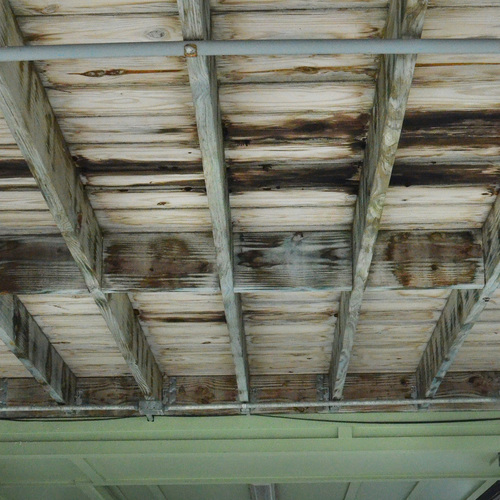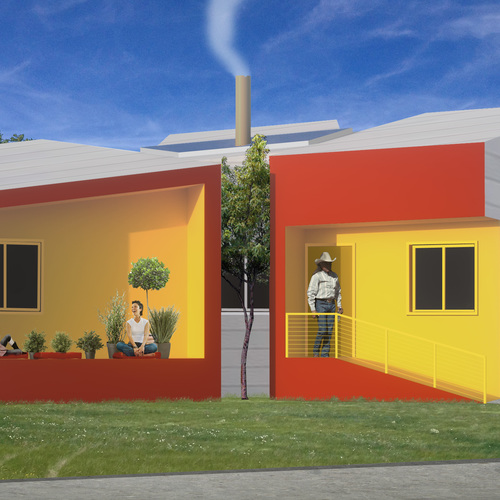
Legal troubles engulfing Brad Pitt’s Make It Right foundation in New Orleans have deepened with the foundation now suing its own architect for overseeing shoddy construction that could cost millions of dollars to repair.
According to published reports, the foundation that built more than 100 houses in the wake of Hurricane Katrina has filed suit against New Orleans architect John C. Williams. NBC News said the foundation paid Williams more than $4 million to produce drawings and oversee the construction of houses designed by a number of big-name architects.
The trendy designs were intended to meet LEED Platinum requirements but instead developed a variety of problems while failing to meet LEED standards, the lawsuit says. They included inadequate waterproofing and flawed roof designs that made the houses susceptible to water damage.
In a news clip posted with the NBC article, Kamaria Allen said she bought one of the foundation’s homes in the Lower Ninth for $130,000 in 2011 and began noticing problems almost immediately. She later moved out of the house and in with her parents, who themselves had bought a Make It Right house with its own moisture problems.
The lawsuit says the design flaws could cost the foundation $20 million in repairs.
The lawsuit says the foundation became aware that some houses developed moisture-related problems within a year of completion and sought advice from Williams on how to correct them. Williams recognized his work was responsible for problems but “suppressed the truth of the conditions and their casual links,” the lawsuit says. Repairs overseen by Williams also were “ineffective.”
GBA placed calls to Williams and to Victor Franckiewicz, identified by the New Orleans Advocate as the attorney who filed the suit earlier this month in Orleans Parish Civil District Court. The calls were not returned. GBA also tried without success, as it has in the past, to reach the foundation’s New Orleans office.
NBC, however, said Pitt had released a statement which said, “I made a promise to the folks of the Lower Ninth to help them rebuild — it is a promise I intend to keep.”
Residents sue Make It Right
In the meantime, an attorney representing people who bought houses from the foundation has made good on his promise to sue the organization for building “substandard homes.”
“While the citizens of the Ninth Ward are grateful to Brad Pitt for starting the rebuilding in their neighborhood,” said a statement from attorney Ron Austin, “they were forced to file this lawsuit because the Make It Right Foundation built substandard homes that are deteriorating at a rapid pace while the homeowners are stuck with mortgages on properties that have diminished values.”
The petition seeking class action status was filed on behalf of Lloyd Francis and Jennifer Decuir. It names the Foundation and a number of its board members, including Pitt.
The complaint alleges that in a 2013 federal tax filing, the Foundation identified problems with building materials that would cost more than $4 million to fix, but never shared the information with homeowners. This omission deprived homeowners of the chance to pursue legal remedies under Louisiana state law.
Beginning in late 2016, the Foundation hired inspectors from Simpson Gumpertz & Heger to go through a number of its homes in the Lower Ninth, but would not share the results with homeowners who repeatedly asked to see them.
The two plaintiffs were recently told that the engineering report would be made available to them when the foundation received it. But they were told that they would have to sign a non-disclosure agreement in order for repairs to begin.
Construction in the Lower Ninth Ward has stopped, with 109 of the originally planned 150 houses actually built, the complaint says. “The Foundation has virtually ceased all repair activity on the 109 Make It Right Homes, with the exception of a few properties some of which appear to be under repair, without the appropriate City building permits,” it says.
In addition, the suit claims, the Foundation has bought back some of the houses that could not be repaired properly, and continues to own a number of undeveloped lots.
An unrelated legal claim pitted the foundation against the manufacturers of TimberSIL, a treated wood used on decks and outside stairs in some of the houses. Make It Right sued the company in 2015 for $500,000 after the wood began rotting. That suit, The Advocate said, has been settled out of court.
Weekly Newsletter
Get building science and energy efficiency advice, plus special offers, in your inbox.















12 Comments
If the foundation built 109 homes, and the $130,000 home was typical of the cost of the others, that's just over $14M total cost for all the homes. It doesn't seem possible that it could cost $20M in repairs as the article states.
Is it a trick of the eye or does the house in the above picture appear to have the roof ridge not level and angling on a slope from front to back? If so, are not ridges supposed to be level?
Level ridge or level eaves. I guess with some architects you have to choose one or the other:
https://www.dezeen.com/2017/11/06/yale-university-architecture-students-create-dwelling-homeless-new-haven-connecticut/?li_source=LI&li_medium=bottom_block_1
Any of the architects here ever contract to "oversee" as opposed to "observe" construction? When I was a practising lawyer, the invariable defense of an architect being sued was that they didn't agree to oversee or supervise the work, but were only liable if they actually observed substandard work.
Stephen,
When we negotiated fees for projects, especially during recessions, the first thing the client would want to cut back on was site visits. We were often stuck between their desire and the professional standards of the association. The result was invariably poor supervision. The usurping of architect's traditional role as coordinating professionals by other consultants has also left a void where it's often not clear who is really responsible.
I'd imagine there are a number of semantic wiggle-phrases now in use to try and limit liability on both sides. What seems unclear is whether the fault was really in the execution of the designs, or the designs themselves - which sure seem to include a lot of problematic architectural conceits.
Malcolm: I remember that the standard AIA form contract between architect and owner limited the architect's liability by avoiding any responsibility on the part of the architect to supervise the execution of the work. I'm sure you're correct that a fee that would include meaningful supervision of the work would be hard for an owner to swallow. And of course having a full-time owner's rep on site is only feasible on large projects.
"What seems unclear is whether the fault was really in the execution of the designs, or the designs themselves"
Sounds like the execution part is to blame, but I'd like to know the truth.
Either way, Brad Pitt's deal is another strike against "green" building practices regardless of who's to blame.
Seems to me more of a strike against celebrity carpet-baggers using "green" as a sales pitch to build their projects.
The headlines at east bay times said "Green Homes Falling Apart".. Nothing about celebrities. https://forums.jlconline.com/forums/album/1075457-green-homes-falling-apart
Whenever you read anything about sick buildings or houses they usually blame the design as being to tight.. And forget the underlying reasons like building didn't even have a ERV or was built by jacklegs etc etc.
I'm at a loss for why we should evaluate 'green" building practices by what the headline in the East Bay Times was, or whether "they" say building are too tight?
Surely the relevant questions are: Do high-performance houses suffer more building envelope failures than others, and is the indoor air quality of these homes worse than the average code minimum ones?
I'm a bit confused by were you are going with this. Do you think energy efficient houses are a bad idea?
Your missing my point. Public perception for green building is it's to risky, and rightfully so after reading about "make it right".
Ah - okay, you are just talking about public perceptions. That's fair enough. Any innovation, whether green or otherwise, is probably best viewed through the lens of skepticism until it's benefits are proven.
My beef is that the things that caused those buildings in New Orleans to fail had very little to do with what we here on GBA would equate with green building, and a lot to do with poor design and construction. "Green" was just used as a way of getting in the door for Make it Right.
https://www.architecturaldigest.com/story/brad-pitt-make-it-right-foundation-new-orleans-katrina-lawsuit
Log in or create an account to post a comment.
Sign up Log in